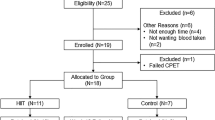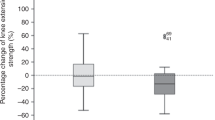Abstract
Chronic cancer-related fatigue in otherwise asymptomatic post-allogeneic hematopoietic stem cell transplant (HSCT) patients is common and debilitating. This pilot study investigated whether patients with no clinical or psychological abnormalities but severe fatigue would respond to an individually adapted aerobic exercise program. Participants were 12 patients (eight male, and four female patients), median age 47 years and 41 months post-HSCT with a variety of hematopoetic cancer diagnoses. All underwent a 12-week individualized mild aerobic exercise program, preceded by a 4-week introduction and baseline testing phase. Psychological measures included fatigue, mood and depression. Exercise-related physiological outcomes included power output at ventilatory threshold 2 (VT2) and associated changes in stroke volume, heart rate, blood lactate concentration and ratings of perceived exertion. Patients were assessed for fatigue before, immediately after and at 3, 6, 9 and 12 months post-program. Significant improvements were found on both measures of fatigue (both P<0.001), with a very large effect size of 1.82 on the The Functional Assessment of Cancer Therapy – Fatigue Module, which were maintained over the follow-up period. Exercise testing revealed a mean increase (P<0.001) of 28% in power output at VT2 with an increase (P<0.001) in stroke volume and a decrease (P<0.001) in heart rate, blood lactate and perceived exertion at pre-intervention VT2 power output.
This is a preview of subscription content, access via your institution
Access options
Subscribe to this journal
Receive 12 print issues and online access
$259.00 per year
only $21.58 per issue
Buy this article
- Purchase on Springer Link
- Instant access to full article PDF
Prices may be subject to local taxes which are calculated during checkout






Similar content being viewed by others
References
Russell JA, Larratt L, Brown C, Turner AR, Chaudhry A, Booth K et al. Allogeneic blood stem cell and bone marrow transplantation for acute myelogenous leukemia and myelodysplasia: influence of stem cell source on outcome. Bone Marrow Transplant 1999; 24: 1177–1183.
Russell JA, Desai S, Herbut B, Brown C, Luider J, Ruether JD et al. Partially mismatched blood cell transplants for high-risk hematologic malignancy. Bone Marrow Transplant 1997; 19: 861–866.
Russell JA, Bowen T, Brown C, Luider J, Ruether JD, Stewart D et al. Second allogeneic transplants for leukemia using blood instead of bone marrow as a source of hemopoietic cells. Bone Marrow Transplant 1996; 18: 501–505.
Russell JA, Brown C, Bowen T, Luider J, Ruether JD, Stewart D et al. Allogeneic blood cell transplants for haematological malignancy: preliminary comparison of outcomes with bone marrow transplantation. Bone Marrow Transplant 1996; 17: 703–708.
Russell JA, Chaudhry A, Booth K, Brown C, Woodman RC, Valentine K et al. Early outcomes after allogeneic stem cell transplantation for leukemia and myelodysplasia without protective isolation: a 10-year experience. Biol Blood Marrow Transplant 2000; 6: 109–114.
Carlson LE, Koski T, Gluck S . Longitudinal effects of high-dose chemotherapy and autologous stem cell transplantation on quality of life in the treatment of metastatic breast cancer. Bone Marrow Transplant 2001; 27: 989–998.
Carlson LE, MacRae JH . Quality of life issues following autologous bone marrow transplantation. Expert Rev Pharmacoeconomics Outcomes Res 2002; 2: 129–146.
McQuellon RP, Russell GB, Rambo TD, Craven B, Radford J, Perry JJ et al. Quality of life and psychological distress of bone marrow transplant recipients: the ‘time trajectory’ to recovery over the first year. Bone Marrow Transplant 1998; 21: 477–486.
Andrykowski MA, Cordova MJ, Hann DM, Jacobsen PB, Fields KK, Phillips G . Patients' psychosocial concerns following stem cell transplantation. Bone Marrow Transplant 1999; 24: 1121–1129.
Fromm K, Andrykowski MA, Hunt J . Positive and negative psychosocial sequelae of bone marrow transplantation: implications for quality of life assessment. J Behav Med 1996; 19: 221–240.
Andrykowski MA, Greiner CB, Altmaier EM, Burish TG, Antin JH, Gingrich R et al. Quality of life following bone marrow transplantation: findings from a multicentre study. Br J Cancer 1995; 71: 1322–1329.
National Comprehensive Cancer Network CRF Panel. Practice Guidelines in Oncology – v.2.2005: Cancer-Related Fatigue. http://www.nccn.org/professionals/physician_gls/PDF/fatigue.pdf. 2005 Available from URL: http://www.nccn.org/professionals/physician_gls.
Visser MR, Smets EM, Sprangers MA, de Haes HJ . How response shift may affect the measurement of change in fatigue. J Pain Symptom Manage 2000; 20: 12–18.
Visser MR, Smets EM . Fatigue, depression and quality of life in cancer patients: how are they related? Support Care Cancer 1998; 6: 101–108.
Smets EM, Garssen B, Schuster-Uitterhoeve AL, de Haes JC . Fatigue in cancer patients. Br J Cancer 1993; 68: 220–224.
Gaston-Johansson F, Fall-Dickson JM, Bakos AB, Kennedy MJ . Fatigue, pain and depression in pre-autotransplant breast cancer patients. Cancer Pract 1999; 7: 240–247.
Hann DM, Garovoy N, Finkelstein B, Jacobsen PB, Azzarello LM, Fields KK . Fatigue and quality of life in breast cancer patients undergoing autologous stem cell transplantation: a longitudinal comparative study. J Pain Symptom Manage 1999; 17: 311–319.
Greenberg DB . Fatigue. In: Holland J (ed). Pyscho-Oncology. Oxford University Press: New York, 1998, pp 483–493.
Dohnalek LJ . Patients undergoing bone marrow transplant benefit from exercise class. Oncol Nurs Forum 1997; 24: 966.
O'Sullivan SE, Bell C . The effects of exercise and training on human cardiovascular reflex control. J Auton Nerv Syst 2000; 81: 16–24.
Winningham ML, Nail LM, Burke MB, Brophy L, Cimprich B, Jones LS et al. Fatigue and the cancer experience: the state of the knowledge. Oncol Nurs Forum 1994; 21: 23–36.
MacVicar MG, Winningham ML, Nickel JL . Effects of aerobic interval training on cancer patients' functional capacity. Nurs Res 1989; 38: 348–351.
Dimeo FC, Tilmann MH, Bertz H, Kanz L, Mertelsmann R, Keul J . Aerobic exercise in the rehabilitation of cancer patients after high dose chemotherapy and autologous peripheral stem cell transplantation. Cancer 1997; 79: 1717–1722.
Schwartz AL . Physical activity after a cancer diagnosis: psychosocial outcomes. Cancer Invest 2004; 22: 82–92.
McTiernan A . Physical activity after cancer: physiologic outcomes. Cancer Invest 2004; 22: 68–81.
Stone P . The measurement, causes and effective management of cancer-related fatigue. Int J Palliat Nurs 2002; 8: 120–128.
Irwin ML, Ainsworth BE . Physical activity interventions following cancer diagnosis: methodologic challenges to delivery and assessment. Cancer Invest 2004; 22: 30–50.
Courneya KS . Exercise in cancer survivors: an overview of research. Med Sci Sports Exerc 2003; 35: 1846–1852.
Holmes MD, Chen WY, Feskanich D, Kroenke CH, Colditz GA . Physical activity and survival after breast cancer diagnosis. JAMA 2005; 293: 2479–2486.
Courneya KS, Keats MR, Turner AR . Physical exercise and quality of life in cancer patients following high dose chemotherapy and autologous bone marrow transplantation. Psycho-Oncology 2000; 9: 127–136.
Wilson RW, Jacobsen PB, Fields KK . Pilot study of a home-based aerobic exercise program for sedentary cancer survivors treated with hematopoietic stem cell transplantation. Bone Marrow Transplant 2005; 35: 721–727.
Yellen SB, Cella DF, Webster K, Blendowski C, Kaplan E . Measuring fatigue and other anemia-related symptoms with the Functional Assessment of Cancer Therapy (FACT) measurement system. J Pain Symptom Manage 1997; 13: 63–74.
Mendoza TR, Wang XS, Cleeland CS, Morrissey M, Johnson BA, Wendt JK et al. The rapid assessment of fatigue severity in cancer patients: use of the Brief Fatigue Inventory. Cancer 1999; 85: 1186–1196.
Zittoun R, Achard S, Ruszniewski M . Assessment of quality of life during intensive chemotherapy or bone marrow transplantation. Psycho-Oncology 1999; 8: 64–73.
Radloff LS . The CES-D scale: a self-report depression scale for research in the general population. Appl Psychol Meas 1977; 1: 385–401.
Spitzer RL, Williams JB, Gibbon M, First MB . The structured clinical interview for DSM-III-R (SCID). I: history, rationale and description. Arch Gen Psychiatry 1992; 49: 624–629.
McNair DA, Lorr M, Droppelman LF . Profile of Mood States. Educational and Industrial Testing Service: San Diego, 1971.
Cassileth BR, Lusk EJ, Brown LL, Cross PA . Psychosocial status of cancer patients and next of kin: normative data from the profile of mood states. J Psychosoc Oncol 1985; 3: 99–105.
Wasserman K, Whipp BJ, Davis JA . Respiratory physiology of exercise: metabolism, gas exchange and ventilatory control. Int Rev Physiol 1981; 23: 149–211.
Svedahl K, MacIntosh B . Anaerobic threshold: the concept and methods of measurement. Can J Appl Physiol 2003; 28: 299–323.
Barker RC, Hopkins SR, Kellogg N, Olfert IM, Brutsaert TD, Gavin TP et al. Measurement of cardiac output during exercise by open-circuit acetylene uptake. J Appl Physiol 1999; 87: 1506–1512.
Dibski DW, Smith DJ, Jensen R, Norris SR, Ford GT . Comparison and reliability of two non-invasive acetylene uptake techniques for the measurement of cardiac output. Eur J Appl Physiol 2005; 94: 670–680.
Borg GA . Psychophysical bases of perceived exertion. Med Sci Sports Exerc 1982; 14: 377–381.
McLellan TM . Ventilatory and plasma lactate response with different exercise protocols: a comparison of methods. Int J Sports Med 1985; 6: 30–35.
Cella D, Lai JS, Chang CH, Peterman A, Slavin M . Fatigue in cancer patients compared with fatigue in the general United States population. Cancer 2002; 94: 528–538.
Dimeo FC . Effects of exercise on cancer-related fatigue. Cancer 2001; 92 (Suppl 6): 1689–1693.
Watson T, Mock V . Exercise as an intervention for cancer-related fatigue. Phys Ther 2004; 84: 736–743.
Gaskill SE, Walker AJ, Serfass RA, Bouchard C, Gagnon J, Rao DC et al. Changes in ventilatory threshold with exercise training in a sedentary population: the HERITAGE family study. Int J Sports Med 2001; 22: 586–592.
Acknowledgements
This study has been generously funded by the Community Opportunity Foundation of Alberta (COFA). We thank Eric Hobson and Robert McKenzie, the foundation's directors and co-founders. Heart Rate Monitors for each participant to keep were supplied by Polar Electro Canada. Mr Alan Hobson has been instrumental in this study, spearheading it based on his own experience as an HSCT survivor. He has served as motivator and consultant throughout the study, both for the study team and the participants. In addition, Mr Cal Zaryski of criticalspeed.com was an additional consultant on matters of physical training. Technical support was provided by Maura Hooper, Kelly Quipp, Rosie Neil, Heather Philpot, Justin Seguin, Gwen Butterfield and Natalie Galloway. Dr Linda Carlson is supported by a Canadian Institutes of Health Research New Investigator Award. Finally, we thank all the survivors who were willing to invest their valuable time and energy into this protocol. They continue to inspire us and other survivors in their cancer journeys.
Author information
Authors and Affiliations
Corresponding author
Rights and permissions
About this article
Cite this article
Carlson, L., Smith, D., Russell, J. et al. Individualized exercise program for the treatment of severe fatigue in patients after allogeneic hematopoietic stem-cell transplant: a pilot study. Bone Marrow Transplant 37, 945–954 (2006). https://doi.org/10.1038/sj.bmt.1705343
Received:
Revised:
Accepted:
Published:
Issue Date:
DOI: https://doi.org/10.1038/sj.bmt.1705343
Keywords
This article is cited by
-
Potential benefits of a virtual, home-based combined exercise and mindfulness training program for HSC transplant survivors: a single-arm pilot study
BMC Sports Science, Medicine and Rehabilitation (2022)
-
Preventing the adverse cardiovascular consequences of allogeneic stem cell transplantation with a multi-faceted exercise intervention: the ALLO-Active trial protocol
BMC Cancer (2022)
-
Late complications and quality of life assessment for survivors receiving allogeneic hematopoietic stem cell transplantation
Supportive Care in Cancer (2021)
-
Prevalence of growth hormone deficiency in patients with unexplained chronic fatigue after undergoing bone marrow transplantation in adulthood
Journal of Endocrinological Investigation (2021)
-
Deconditioning, fatigue and impaired quality of life in long-term survivors after allogeneic hematopoietic stem cell transplantation
Bone Marrow Transplantation (2018)



